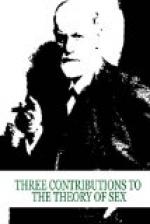INTRODUCTION TO TRANSLATION
The somewhat famous “Three Essays,” which Dr. Brill is here bringing to the attention of an English-reading public, occupy—brief as they are—an important position among the achievements of their author, a great investigator and pioneer in an important line. It is not claimed that the facts here gathered are altogether new. The subject of the sexual instinct and its aberrations has long been before the scientific world and the names of many effective toilers in this vast field are known to every student. When one passes beyond the strict domains of science and considers what is reported of the sexual life in folkways and art-lore and the history of primitive culture and in romance, the sources of information are immense. Freud has made considerable additions to this stock of knowledge, but he has done also something of far greater consequence than this. He has worked out, with incredible penetration, the part which this instinct plays in every phase of human life and in the development of human character, and has been able to establish on a firm footing the remarkable thesis that psychoneurotic illnesses never occur with a perfectly normal sexual life. Other sorts of emotions contribute to the result, but some aberration of the sexual life is always present, as the cause of especially insistent emotions and repressions.
The instincts with which every child is born furnish desires or cravings which must be dealt with in some fashion. They may be refined ("sublimated"), so far as is necessary and desirable, into energies of other sorts—as happens readily with the play-instinct—or they may remain as the source of perversions and inversions, and of cravings of new sorts substituted for those of the more primitive kinds under the pressure of a conventional civilization. The symptoms of the functional psychoneuroses represent, after a fashion, some of these distorted attempts to find a substitute for the imperative cravings born of the sexual instincts, and their form often depends, in part at least, on the peculiarities of the sexual life in infancy and early childhood. It is Freud’s service to have investigated this inadequately chronicled period of existence with extraordinary acumen. In so doing he made it plain that the “perversions” and “inversions,” which reappear later under such striking shapes, belong to the normal sexual life of the young child and are seen, in veiled forms, in almost every case of nervous illness.
It cannot too often be repeated that these discoveries represent no fanciful deductions, but are the outcome of rigidly careful observations which any one who will sufficiently prepare himself can verify. Critics fret over the amount of “sexuality” that Freud finds evidence of in the histories of his patients, and assume that he puts it there. But such criticisms are evidences of misunderstandings and proofs of ignorance.




